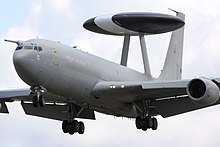


A radome (a portmanteau of "radar" and "dome") is a structural, weatherproof enclosure that protects a radar antenna.[1] The radome is constructed of material transparent to radio waves. Radomes protect the antenna from weather and conceal antenna electronic equipment from view. They also protect nearby personnel from being accidentally struck by quickly rotating antennas.
Radomes can be constructed in several shapes – spherical, geodesic, planar, etc. – depending on the particular application, using various construction materials such as fiberglass, polytetrafluoroethylene (PTFE)-coated fabric, and others.[2]
In addition to radar protection, radomes on aircraft platforms also act as fairings that streamline the antenna system, thus reducing drag. When found on fixed-wing aircraft with forward-looking radar, as are commonly used for object or weather detection, the nose cones often additionally serve as radomes. On airborne early warning and control (AEW&C) aircraft (e.g. the American E-3 Sentry), a discus-shaped rotating radome, often called a "rotodome", is mounted on the top of the fuselage for 360-degree scanning coverage. Some newer AEW&C configurations instead use three 120-degree phased array modules inside a stationary radome, examples being the Chinese KJ-2000 and Indian DRDO AEW&Cs. On fixed-wing and rotary-wing aircraft using microwave satellite for beyond-line-of-sight communication, radomes often appear as bulged "blisters" on the fuselage.[3]
The use of radomes dates back as far as 1941.[4]
The air supported radome built by Walter Bird in 1948 at the Cornell Aeronautical Laboratory is the first pneumatic construction built in history.[5][2]
- ^ Wragg, David W. (1973). A Dictionary of Aviation (first ed.). Osprey. p. 220. ISBN 9780850451634.
- ^ a b Latifiyan, Pouya (August 28, 2022). "What is Radome?". Qoqnoos Scientific Magazine. 1: 13.
- ^ example of helicopter radome
- ^
Kozakoff, D. J. (2010). Analysis of Radome-enclosed Antennas. Artech House antennas and propagation library (2 ed.). Norwood, Massachusetts: Artech House. p. 3. ISBN 9781596934429. Retrieved November 22, 2024.
In 1941, the first in-flight radome was a hemispherical nose radome fabricated from Plexiglas. It protected an experimental S-band, Western Electric radar flown in a B018A aircraft.
- ^ Collado Baíllo, Isabel. "Walter Bird y las primeras construcciones neumáticas". Revista Europea de Investigación en Arquitectura. 20: 119–140.